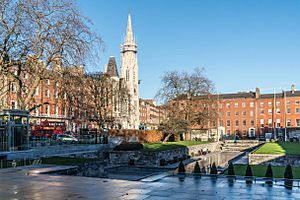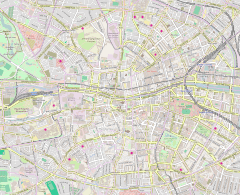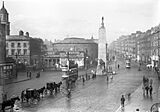Parnell Square facts for kids
| Cearnóg Parnell (Irish) | |

Parnell Square looking towards Abbey Presbyterian Church from the Garden of Remembrance
|
|
| Former name(s) | Rutland Square |
|---|---|
| Namesake | Charles Stewart Parnell |
| Area | 4.4 hectares (11 acres) |
| Location | Dublin, Ireland |
| Postal code | D01 |
| Coordinates | 53°21′11″N 6°15′48″W / 53.353165°N 6.263286°W |
| Other | |
| Known for | Hugh Lane Gallery |
Parnell Square (Irish: Cearnóg Parnell) is a famous square in the city of Dublin, Ireland. It is located at the northern end of O'Connell Street. The square is known for its beautiful old buildings, built in a style called Georgian architecture. It is part of Dublin's D01 postal district.
Contents
History of Parnell Square
Parnell Square was once called Rutland Square. It was renamed after Charles Stewart Parnell, an important Irish political leader who lived from 1846 to 1891. The street next to it, Parnell Street, was also named after him.
The square is surrounded by many original Georgian houses. These are grand, old buildings from the 1700s and 1800s. A large part of the square is taken up by the Rotunda Hospital. This hospital was Europe's very first maternity hospital, built for mothers having babies.
On the northern side of the square, you will find the Garden of Remembrance. This special garden is a memorial to all those who gave their lives for Irish freedom.
Famous Buildings and Places
Parnell Square is home to many interesting buildings and places.
Arts and Culture on the Square
- The Gate Theatre is at the southeastern corner of the square. It's a famous place for plays and shows.
- The Hugh Lane Gallery is on the north side. It's an art museum located inside Charlemont House, one of the grandest houses on the square. This house was designed by William Chambers.
- Nearby, you can find the Dublin Writers Museum and the Irish Writers' Centre. These places celebrate Ireland's famous writers.
- Findlater's Church, also known as Abbey Presbyterian Church, is a striking church built in the 1860s. It has a unique Gothic Revival style.
- Chapter One, one of Dublin's most popular restaurants, is also on the northern side.
Other Notable Spots
- Conway's bar (now closed) on the south side is famous because Patrick Pearse, a leader of the 1916 Easter Rising, surrendered to the British Army outside it.
- The political party Sinn Féin has its Dublin office and shop on the western side of the square.
- The western side also has offices for many trade unions and other groups.
- The St. Martin's Apostolate office is here too. It's well-known for its beautiful Christmas crib that people can visit each year.
People and Events from History
Many important people lived or had significant events happen on Parnell Square.
Homes of Famous People
- No. 5 was the birthplace of Oliver St John Gogarty (1878–1957). He was a writer, surgeon, and senator. He was friends with Michael Collins and writers like W. B. Yeats and James Joyce.
- No. 9 Cavendish Row was where Dr. Bartholomew Mosse (1713–1759) lived. He was a kind doctor who founded the Rotunda Hospital. He also created the pleasure gardens around the hospital to help pay for it.
Important Meetings and Events
- No. 14 Parnell Square was the headquarters of Conradh na Gaeilge (the Gaelic League) for many years. This group works to promote the Irish language.
- No. 25 Parnell Square is very important to Irish history. In 1914, a secret meeting was held here by the Irish Republican Brotherhood (IRB). They decided to plan a rebellion against the British before World War I ended. Many key figures of the Easter Rising were at this meeting, including Éamonn Ceannt and Padraig Pearse.
- No. 29–30 Parnell Square was once Vaughan's Hotel. It was a favorite secret meeting place for Michael Collins, another famous Irish leader.
- No. 41 Parnell Square was the Irish National Forester's Hall. Before the 1916 Easter Rising, groups like the Irish Republican Brotherhood used it for training. On the night before the Rising, Éamon de Valera gathered his battalion here.
- No. 44 Parnell Square is currently the main office for Sinn Féin. It is also known as the Kevin Barry Memorial Hall.
- No. 46 Parnell Square was another headquarters for Conradh na Gaeilge. In 1916, Thomas MacDonagh gathered his battalion here on the night before the Easter Rising. Later, in 1917, important meetings were held here to set up the Irish Republican Army. In 1919, Michael Collins formed his famous "Squad" here. This group carried out very important missions.
- No. 58 Parnell Square is home to the Sinn Féin Bookshop and the offices of the An Phoblacht newspaper.
Future Plans for the Square
There are plans to make the northern side of Parnell Square into a special cultural area. The street will become a place just for people to walk. Dublin's main library will move into the old Coláiste Mhuire buildings. A new concert hall will also be built. The gardens near the Rotunda Hospital will be opened up for everyone to enjoy.
Gallery
- Views Around Parnell Square
-
Dublin tramways running through Parnell Square and O'Connell Street in the early 20th century
-
Northern side of Parnell Square, with the Garden of Remembrance at left, Hugh Lane Gallery recessed at right, and former Coláiste Mhuire buildings at far end
Images for kids








